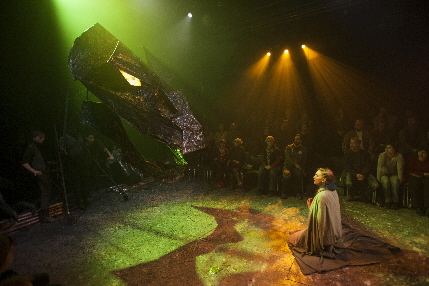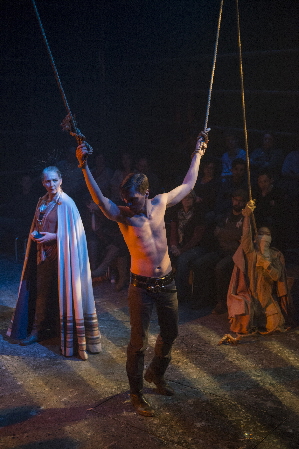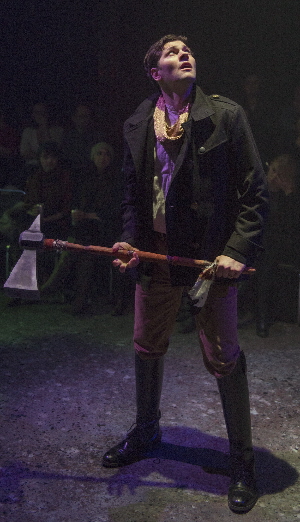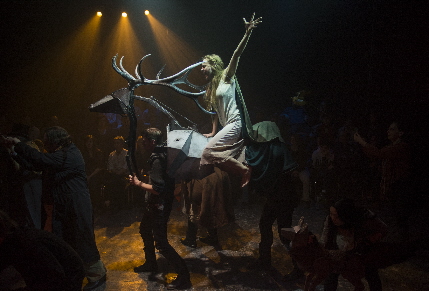
Irek Obsidian (voiced by Tracy Letts) confronts his daughter July
(Kay Kron) in the third play of The Hammer Trinity from the House Theatre of Chicago and the Arsht Center / Photos by Michael Brosilow
By Bill Hirschman
There are two crucial and easily misunderstood aspects to comprehend about The Hammer Trinity, a piece of epic storytelling playing eight weekends at the Arsht Center beginning this Saturday, produced by the hyper-imaginative House Theatre of Chicago and commanding a $150 ticket.
Yes, it is three related plays stretched over more than nine hours that can only be seen in the theatrical equivalent of binge watching from 1 p.m. to 10:45 p.m., on Saturdays and Sundays.
But there are breaks and intermissions every 65 minutes plus an hour-long dinner break in which you can schmooze with the cast over a meal that you buy there or bring yourself.
And yes, the story is a kind of Arthurian fantasy legend superimposed on a parallel universe United States– a mélange of fantasy, comic books, Game of Thrones, Lord of the Rings, westerns, pirates tales, and an attempt to create a kind of mythological world.
But it’s also designed to be funny, inspiring, heart-felt and, a serious examination of what is the American identity, what do we want in leadership, how do we choose leaders. Youngsters should enjoy it, but the production is trying to provide meat for all ages, ethnicities and interests.
“It’s not epic because it’s long,” said co-writer and House artistic director Nathan Allen. “It’s an epic because it’s grand in its ambition to mythologize the American identity. It asks questions about the greater good versus our personal liberties” – themes that should resonate in this election season, even though the House pointedly wants to avoid any overtly political message.
But those themes are swathed in the generation-crossing highly theatrical storytelling style that the House has been bringing to the Arsht since The Sparrow in 2011, notably in its Death and Harry Houdini. Expect to see battling puppets, immersive sound and light shows, tongue-in-cheek humor, a couple of 18-foot dragons, its own comic book, and a sonorous voice recorded by Chicago actor Tracy Letts, the Pulitzer and Tony-winning playwright of August: Osage County.
Like their other productions, it’s touted as the kind of theater for people who think they don’t like theater.
“We’re very concerned and conscious of what we’re asking of people. We’re not wanting people to think they are going to six hours of boring theater,” said Chris Mathews, co-writer of the script.
Allen said, “It’s a ride for a day. It’s an adventure story. It’s engaging. It’s not sullen or precious. It accelerates all though the day, faster and faster until it’s bursting at the seams.”
Based on the initial production in Chicago, by the time the odyssey is done, the audience has bonded with each other as well as the actors, he said. “You spend the day with 200 people you didn’t know. Everyone feels amped. At the end they are high fiving and hugging.”
The scope is startling, one of the last big-budget co-productions that former Executive Vice President Scott Shiller engaged before leaving to run the Denver Center. Shiller believed in building new, young and diverse audiences with such multi-media spectacles as H2OMBRE and The Donkey Show.
The Hammer Trinity certainly qualifies: about 18 actors playing 51 characters in 114 scenes across 7 acts; 456 pages in the script; 312 costume changes with 450 costume pieces; 15 puppets; 798 light cues plus 2,854 sound and music cues; only one actor plays only one role, but former Miamian Patrick Falcon playing a dozen and dying frequently.
Using seed money from the Arsht, the House team developed the project over six years. It unveiled one part at its Chicago home in 2012, then added the second part and finally all three parts played for two months in the spring of 2015. Although patrons could see one or two of the shows independently on different days and even forego one of the three, enthusiastic audiences seemed intent on seeing all three parts all at one time, Allen said.
Now the Arsht’s Carnival Studio Theatre black box space usually occupied by Zoetic Stage has been turned into a long aisle-like playing space as the House did with Houdini. Risers are on both sides and the whole thing is encased with horizontal poles like a cage to create its own world.
The plot is listed in publicity materials this way:
 PART ONE: THE IRON STAG KING
PART ONE: THE IRON STAG KING
Casper Kent, is the son of a poor farmer. When an old storyteller, Hap the Golden, reveals that Casper is the rightful heir to the Crown, his life is threatened from all sides. Casper must escape the Crownless, choose compatriots and question what is good and right for the land. We follow him on his quest to lift the magical Hammer that will unite or destroy them all.
PART TWO: THE CROWNLESS KING
After a hard-fought battle, Kent takes his place as the ruler of the Folk. Yet King Casper soon finds himself buffeted by forces on all sides. Seizing for control, the exiled black dragon, Irek Obsidian cunningly lures Casper away from the throne. Our band of heroes ventures to the sea where the hooded pirate Davy Boone commands a fleet of Crownless rebels. All the while, Hap the Golden wrests to maintain his hold over the royal tale. Storytellers Hap the Golden and Irek Obsidian each seek to impose their versions of the story. But a third Storyteller will emerge to speak a new story….
PART THREE: THE EXCELSIOR KING
New Plymouth is thrust into Civil War as the Folk choose sides in the conflict between Hap the Golden and Irek Obsidian. With Queen Rienne potentially murdered, and King Casper nowhere to be found, our remaining heroes have narrowly escaped the conflict in the Capital but find themselves scattered and at cross-purposes. It is up to the novice storyteller, July of the Seven Foxes to speak a tale that can unite them again and save the Land from self-destruction. But a threat worse than dragons is encroaching from The Glaze, a darkness more powerful than even Hap and Irek had anticipated.

King Casper (Kevin Stangler) returns to the Bridge Bell, striking it with the Hammer to announce the rule of The Crownless King
Such undertakings are rare in western theater. The Royal Shakespeare Company’s The Life and Adventures of Nicholas Nickleby and the Denver Center’s Tantalus come to mind from a previous decade. They are unusually expensive and Allen laughed when asked if ticket sales recoup the cost of production. Allen doubted the show would ever be mounted again. Without the Arsht, Allen said, “It should have died last year. This is a gift.”
The Arsht declined to say how much the production cost or how much it contributed for the development early on. But the project was one of the 10@10 commissions of new work that the Arsht budgeted $300,000 toward to celebrate its 10th anniversary. That money underwrote the evolution of the piece before it opened in Chicago.
But Allen and others say that the project’s worth goes beyond cash flow; it’s an investment in attracting and building a deeper, younger and wider audience.
Asked about the risk of such a costly and expansive project, Liz Wallace, vice president of programming at the Arsht Center, wrote, “There is always risk in presenting unknown work. It takes a committed theatergoer to take the leap with the playwright and the performers, which can be very rewarding. The idea to commission new work for our 10th Anniversary Season is the Arsht Center’s contribution to the arts community, on a local level and beyond, and to the future of the art form. It is the Center’s way of celebrating our signature Theater Up Close series during our anniversary season.”
It’s a major investment for the cast as well, most of whom did the show ten months ago in Chicago and who have contributed ideas as the project evolved, said Falcon, a 2009 graduate of the New World School of the Arts. Even after the long break, “it was surprising easy and fluid to get back into it… because we built it together,” he said. It also helped that the company filmed the production and actors could consult DVDs.
The Arsht has set the ticket prices at $150 – meaning a family of four will spend $600 on tickets plus $20 for parking and the cost of dinner. The ticket in Chicago was $65.
The explanation in a statement from the Arsht was “The pricing for each of these three plays is consistent with our Theater Up Close series pricing, which has been in the $50 range per show. As you know, we are presenting all three together as a marathon in support of the artistic vision of the show’s creators and with respect to how we feel the audience would most enjoy the plays.”
Under consideration is giving families or small groups the kind of discount that are given to large group sales, although that was not certain.
Logistically, there will be frequent breaks for the young and ADHD, but each section ends with a cliffhanger. The Arsht will sell snacks and sandwiches at every break ranging from $8 to $15. The theater will also sell dinners to patrons as will the adjacent Books & Books, although you can bring your own.
Audience members get a sticker saying “I got hammered” at the end of the day.
It will be a unique experience no matter what how it lands.
Allen said with genuine enthusiasm, “I just hope people come see it because they will never see anything like it again.”
The Hammer Trinity from the House Theatre of Chicago and the Arsht Center’s Theater Up Close series will perform at 1 p.m. Saturdays and Sunday April 2 through May 8 in the Carnival Studio Theater at the Arsht Center’s Ziff Ballet Opera House, 1300 Biscayne Boulevard, Miami. Tickets are $150. Running time is about 9 ½ hours. (305) 949-6722 or www.arshtcenter.org.

July calls to all the animals of the Land to come to Casper’s aid in battle Puppets created by Jesse Mooney-Bullock, Kay Kron as July









 A PaperStreet Web Design
A PaperStreet Web Design
